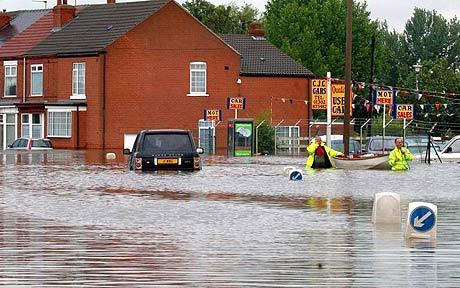
The most detailed set of climate change projections ever produced will show the risks of sea level rise, droughts and floods in Britain over the next 80 years to within 16 miles of your front door.
The set of predictions from the Met Office will forecast temperature, rainfall, sea level rise and even sunshine up until 2099.
It is the most comprehensive climate change forecast to be produced anywhere in the world, showing details of how each area will be affected down to a 25km (16 mile) square grid.
Comment: The most comprehensive forecast anywhere in the world
Except the MET Office cannot get current forecasts that are actually only months into the future correct.
More hot air from UK Meteorology Office
Mittens in Britain but the heat is coming
UK Met Office Summer Forecast: Drowning Again?
Rainfall In Britain Worst In 200 Years
At some point the question must be asked:
Is all this hype and lying about global warming on purpose?
And Why?
Local authorities, the Environment Agency, primary health care trusts, insurance companies and property developers are all eagerly awaiting the content to be revealed to the House of Commons by Hilary Benn, the Environment Secretary, this week.
It is expected the results will not only affect larger building projects and flood defences but property prices and insurance claims for people living near the coast or on flood plains. It will also inform health authorities planning for heat waves or new infectious diseases and farmers deciding which crops to plant in the future.
James Murphy, Head of Predicting Climate Change at the Met Office, said the UK is now "tied into" climate change whatever measures are taken to reduce greenhouse gases because there is so much carbon dioxide already in the atmosphere. Therefore it was possible to predict a range of possibilities for each area, from the best to the worst case scenarios, based on climate models.
"It will give us the information from which the risk associated with future changes in frequency of floods, droughts or heat waves can be predicted which will be very relevant information for the insurance industry and other planners and stake holders," he said.
Comment: What about the great predictions of snow and ice and sub-freezing temperatures?
One more winter either this year or next when people are cold and freezing, one more year of reduced crop yields and failures, then will the blatant disregard for human suffering be seen?
Will the cult of belief and arrogance of the infallability of self finally fall? For that is surely what this is. Computer models built to reinforce personal belief, pushed to the masses regardless of the true data, regardless of the impact on human life.
The predictions will be broken down across 23 river basins, 16 administrative regions and eight costal areas. Each area will be given a range of probabilities based on climate change models so it is possible to work out the likelihood of drought, heat waves, flooding etc and plan accordingly. Predictions will be made for eight overlapping 30 year periods from 2009 to 2099. The first period is 2009 to 2039, then 2019 to 249 and so on.
The predications are expected to show areas of Norfolk could be flooded by seawater by the end of the century. Temperature increases mean London could experience temperatures of up to 41 degrees C by 2080 and East Anglia could experience 60 per cent less rainfall making agriculture increasingly difficult.
Bill Maguire, Professor of Geophysical Hazards at University College London, said people will realise the risk of flooding, sea level rise and droughts on their own doorstep for the first time.
"Ordinary people will be able to see how critical climate change is and how it is going to effect our country as well as tropical low-lying countries like Bangladesh. When they see how their little patch of land is affected they will realise how their own lives will be affected and the lives of their children. It will hammer it home."
The Association of British Insurers will also be watching.
"The insurance industry will use the data to better comprehend future risks and to advise customers and policy-makers on how to prevent or prepare for them," said a spokesman.



Comment: How will the governments and mass media control the insurrection when the lie of global warming is revealed by reality?
What psychological weapon will they unleash next? Pandemic? War?